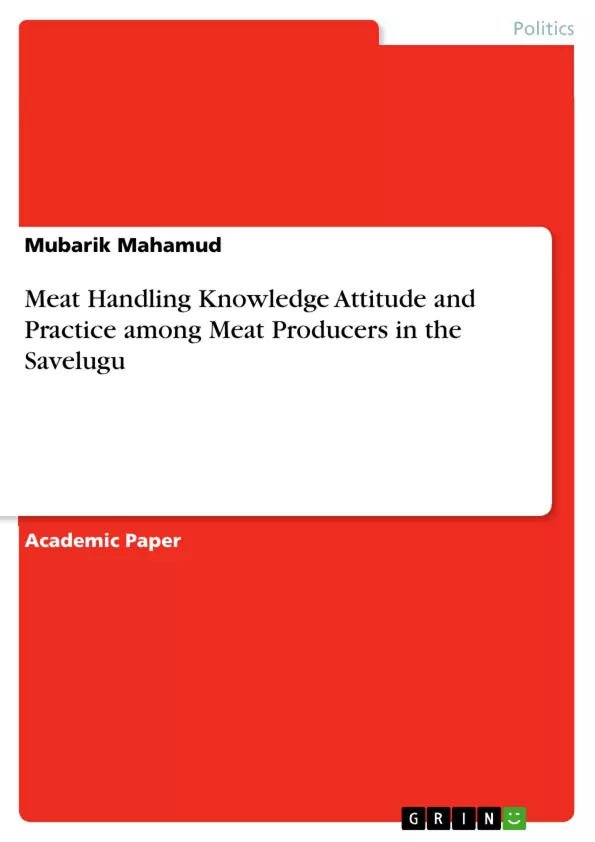The purpose of this study is to determine the level of knowledge, attitude and practices towards meat hygiene among butchers in Savelugu in the Savelugu Municipality of the Northern region of Ghana.
Ghana's livestock industry is essential to the country's development and progress economically, as seen by the over 3 million animals sent there each year. Also, the industry contributes to 60% of new job possibilities while also making up 40% and 80% of Ghana's GDP and foreign exchange profits, respectively.
Meat hygiene is most simply defined as the conditions and actions required to guarantee the appropriateness and safety of meat at all points in the supply chain for meat and goods associated to it. The majority of meat inspectors in underdeveloped nations and rural abattoirs lack the necessary skills, expertise, and information to properly assess the hygienic conditions of the organs, meat, and corpses of the killed animals. Although meat contains a high percentage of nutrients, it is frequently contaminated, which can cause food-related ailments in consumers.
In addition, inappropriate handling of food is the main contributor to outbreaks of food-related diseases, including food poisoning. Raw meat is particularly susceptible to contamination. Most often, contamination occurs when food that doesn't need to be cooked, such salad, is prepared on a surface that was previously used to prepare raw meat without being properly cleaned.
Before an animal is killed, it must be carefully examined, and there must be an inspection procedure going on as the animal is being killed. These efforts are very important for preventing animal-related diseases and making sure that the public receives nutritious meat. Many developing nations' slaughterhouses lack sufficient slaughtering and processing equipment, clean water sources, effective sewage or waste disposal systems, and refrigerated facilities. For instance, in Ghana, this has resulted in contaminated meat and inadequate waste disposal practises.
Inhaltsverzeichnis (Table of Contents)
- Abstract
- List of Tables
- Chapter one
- Introduction
- Background to this study
- Statement of the problem
- Research objectives
- Main research objective
- Specific research objectives
- Research questions
- Main research question
- Specific research questions
- Delimitations
- Organisation of the rest of this study
- Chapter two
- Literature review
- Introduction
- Sanitation of slaughterhouse
- Slaughter techniques
- Stunning methods of slaughter
- Non-stunning methods of slaughter
- Meat hygiene and safety
- Meat Hygiene
- Knowledge and meat hygiene practices among meat handlers
- Chapter three
- Methodology
- Introduction
- Study area
- Study Design
- Sample size determination
- Data Collection
- Data Analysis
- Chapter four
- Results and discussion
- Introduction
- The Respondents' demographic information
- Knowledge of meat hygiene among butchers
- Food borne illness
- Personal hygiene
- Cross-contamination
- Attitude of meat hygiene among butchers, butchers
- Meat hygiene practices of butchers
- Chapter five
- Summary, conclusion and recommendations
- Introduction
- Summary
- Conclusion
- Recommendations
- References
- Appendix
Zielsetzung und Themenschwerpunkte (Objectives and Key Themes)
This project work examines the knowledge, attitude, and practice of meat hygiene among butchers in Savelugu, Ghana. The study aims to assess the level of awareness and adherence to proper meat handling practices among butchers in the region. The main objectives are to identify the factors influencing meat hygiene practices, evaluate the effectiveness of current training and educational initiatives, and ultimately provide recommendations to improve meat hygiene standards in Savelugu.- Knowledge of Meat Hygiene
- Attitudes towards Meat Hygiene
- Practices of Meat Hygiene
- Socio-demographic Factors influencing Meat Hygiene
- Recommendations for Improving Meat Hygiene Standards
Zusammenfassung der Kapitel (Chapter Summaries)
- Chapter one: Introduction This chapter presents the background information and context of the study, outlining the significance of meat hygiene in developing countries like Ghana. It establishes the research objectives and questions, outlining the specific areas that the study will focus on.
- Chapter two: Literature review This chapter examines existing literature related to meat hygiene practices, focusing on slaughterhouse sanitation, different slaughter techniques, and the importance of meat hygiene and safety. It explores the existing knowledge and practices of meat handling among butchers, providing a foundation for the study's findings.
- Chapter three: Methodology This chapter details the research methods used in the study, including the study area, design, sample size determination, data collection techniques, and data analysis procedures. It provides a clear explanation of the methods used to collect and analyze data related to meat hygiene practices among butchers in Savelugu.
- Chapter four: Results and Discussion This chapter presents the findings of the study, analyzing the data collected on the butchers' knowledge, attitudes, and practices concerning meat hygiene. It explores the relationships between socio-demographic characteristics and meat hygiene practices, providing insights into the factors that influence these practices.
Schlüsselwörter (Keywords)
This project focuses on meat hygiene practices in the context of Savelugu, Ghana. The key terms and concepts explored include meat hygiene, butchers, knowledge, attitudes, practices, socio-demographic factors, and recommendations for improving meat handling practices.- Arbeit zitieren
- Mubarik Mahamud (Autor:in), 2023, Meat Handling Knowledge Attitude and Practice among Meat Producers in the Savelugu, München, GRIN Verlag, https://www.hausarbeiten.de/document/1436849


